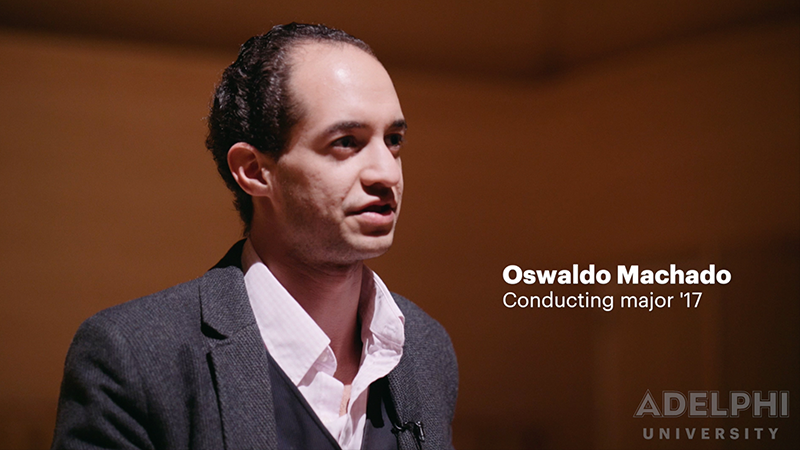Video Guidelines
Video is an engaging medium to showcase Adelphi’s most compelling stories, provide useful information and entertain the Adelphi community.
The process of video production is time-consuming and costly; more planning done upfront can minimize the time in the editing room and reduce your bottom line.
Initial planning should begin with a creative brief in which the key messaging, audience, duration, distribution channels, proof points, call to action and any other necessary details are hashed out and discussed. Use the following handy template for your next video kickoff planning event.
Download Creative Brief (PDF)
Tips for Taking Great Videos
Once the initial details are hashed out, production planning—key players, schedules and important dates—should be established and scripts can be written.
If you are planning on an upcoming video shoot, prepare the people who will be in front of the camera with the following important tips:
- Don’t wear clothing with tight patterns. Checks, houndstooth or pinstripes cause an optical illusion that looks bad on video.
- Avoid wearing black, white, bright orange or bright reds. These colors can cause problems on video.
- For dress shirts, avoid bright white if possible. If you wear a bright white shirt or blouse, make sure to wear a darker jacket over it.
- Jewelry: Watch out for jewelry that reflects light or makes noise, like bangles.
- Eyeglasses: Wear them if you need them to see or if that is how people will recognize you. If your lenses are very shiny, the crew may adjust their position to avoid unwanted reflections.
- Makeup and hair: Wear makeup to cover up blemishes and reduce perspiration. You may want to bring a handkerchief or tissues to dab perspiration during breaks.
- If you’ll be wearing a tie, simple is best—bring options. Avoid complex patterns, thin lines, or bright reds and oranges.
- Have fun. Try to relax and enjoy the process. We are here to help make this a productive and positive experience for you. Your preparation and willingness to listen to our advice are key to your video success.
Tips for Taking Self-Recorded Videos
Professional filmmaker, Gus Cantavero, walks you through the tech requirements and best practice setups to turn your smartphone into a home studio and make a quality, watchable video of your lecture or tutorial.
Uploading to YouTube
Once your video has been edited and is ready to share, we recommend starting a YouTube channel in which this video and others you make in the future can reside.
Video Assets
All videos produced internally or through outside resources are required to include the following elements.
Adelphi Bug
A bug is similar to a watermark on paper—it’s a logo often used in the lower portion of the screen to increase brand recognition. To give the Adelphi brand a proper place in your next video, include the Adelphi logo as a bug in the lower right-hand corner of your video at the size and color shown below:
 Landscape
Landscape
Download Logo Bug (PSD)
Lower Thirds
It is always important to identify who is speaking in your video. Lower thirds can float on-screen and should appear in Graphik or, when not available, in Arial.
Filmmakers are encouraged to typeset the lower third text within their chosen video editing software—using the example below as a reference:

Closer
The Adelphi closer should appear at the end of all videos.

Download the Closer/Outro (MOV)
Title Card
Although not required, title cards or video openers can communicate the main message or give a catchy title to your video. Openers can be animated—have a solid background or float over the video. They should appear in Graphik or, when Graphik is not available, Arial.
We do encourage having a cold opener, jumping directly into the story and leaving the title card to a point further into the story.
 Landscape
Landscape
Download Title Card (PSD)
How to Transcribe/Caption Your Videos
As part of our diversity and inclusion mission, and to meet Americans with Disabilities Act (ADA) guidelines, University videos are required to have transcriptions, or captions, available. This is designed to assist people who are deaf, hard of hearing, listening in an environment where they can’t access audio, or who are accessing audio that is not in their native language. See details in the Rehabilitation Act (Sections 508 and 504).
UCOMM-produced videos
- UCOMM will submit the video for closed captioning to Rev.
- Captions will then be reviewed by UCOMM for accuracy.
Videos produced by departments or individuals
- YouTube provides auto-generated closed captioning on all videos.
- Please note these captions can contain errors. We suggest you review before they go live. See YouTube’s instructions for editing captions.
- If you have funding available, you can use Rev; this service gives you better-quality captions.
Questions? UCOMM is glad to offer guidance and support for video captioning. Reach out at ucomm@adelphi.edu.